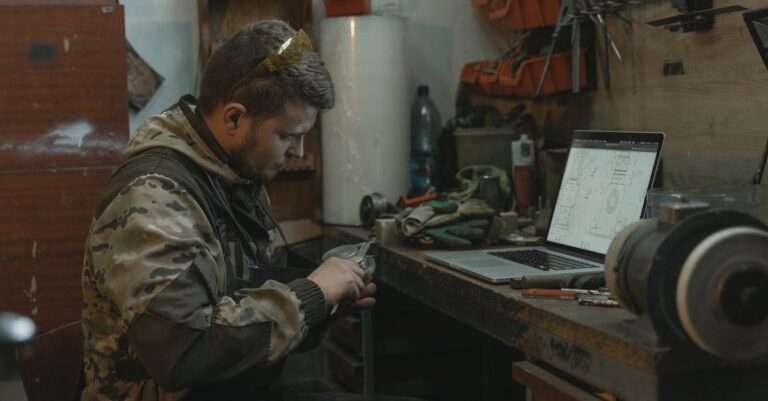In today’s world, working from home has become the new norm, and it’s high time to transform that makeshift desk into a DIY home office that inspires productivity. Why settle for a cluttered kitchen table when you can create a stylish workspace that even your cat will envy? A well-designed office can elevate your mood and boost your efficiency, turning those pajama-clad workdays into a delightful experience.
Imagine sipping your morning coffee in a space that reflects your personality, complete with quirky decorations and the perfect lighting. It’s not just about aesthetics; a functional home office can help separate work from home life—because nobody wants to attend a Zoom meeting while sitting on the couch in their fuzzy slippers. Let’s dive into the exciting world of DIY home offices and discover how to turn your workspace dreams into a reality, one fun project at a time.
Table of Contents
ToggleBenefits Of A DIY Home Office
Creating a DIY home office offers significant advantages. Not only does it enhance the work environment, but it leads to better overall productivity and savings.
Increased Productivity
A well-structured DIY home office boosts focus and efficiency. Individuals find that customizing their workspace reduces distractions. Personalizing the office according to specific needs often results in a more comfortable environment. Enhanced comfort encourages longer work hours without feelings of fatigue. Improved organization through DIY projects streamlines daily tasks, allowing for smooth workflow. Studies show that employees working from dedicated spaces often report higher job satisfaction, driving better results.
Cost-Effectiveness
DIY home offices provide financial benefits. Constructing a workspace from existing materials minimizes expenses. Many individuals save money by repurposing furniture, which reduces the need for new purchases. By eliminating daily commuting, remote work leads to lower travel costs and less wear on vehicles. Investing in a DIY office setup can also increase property value by creating functional space. Studies indicate that homeowners with well-designed home workspaces can attract buyers willing to pay more.
Essential Elements Of A DIY Home Office

Creating a DIY home office requires careful consideration of essential components that contribute to functionality and comfort.
Furniture Selection
Choosing appropriate furniture plays a crucial role in establishing an efficient workspace. Desks should provide ample surface area while allowing for comfortable seating arrangements. Ergonomic chairs promote posture and minimize discomfort during long work hours. Storage solutions such as shelves or filing cabinets help keep the workspace organized, reducing clutter. Consider multi-functional furniture like foldable desks or adjustable standing desks to maximize space. Personal touches, such as decorations or plants, enhance the overall feel of the office.
Technology Requirements
Equipping the office with necessary technology ensures productivity and efficiency. Reliable internet access, typically via high-speed Wi-Fi, is essential for seamless work. A computer or laptop with sufficient processing power handles multiple applications. Printers facilitate document management, enabling easy access to hard copies. Regular software updates and security measures protect data and ensure smooth operation. Additional peripherals, like noise-canceling headphones or webcams, enhance communication and focus during meetings. Prioritizing these technological aspects fosters a supportive work environment.
DIY Home Office Design Ideas
Creating a functional home office requires thoughtful design and use of space. Various DIY projects can enhance both productivity and aesthetics.
Space Optimization
Maximize available space by utilizing vertical surfaces. Wall shelves provide storage without consuming floor space. Use multi-functional furniture, including desks with built-in storage, to reduce clutter. Consider corner desks, which efficiently utilize often-overlooked areas. Lighting plays a vital role; bright, task-focused lamps can enhance the workspace’s overall feel. Organization tools like pegboards or wall-mounted organizers keep essentials accessible, making daily tasks easier. Effective space planning can transform even a small area into a highly productive environment.
Personalization Tips
Infuse personal style into the workspace to foster creativity. Choose a color palette that aligns with individual preferences, as hues influence mood and motivation. Artwork and photography can make the office feel welcoming, so select pieces that inspire. Additionally, adding greenery through plants promotes a calming atmosphere. Customizable elements, like cushions or desk accessories, enhance comfort and visual appeal. Use motivational quotes or vision boards for daily inspiration. Each personalized touch shapes the office into a unique reflection of the individual, creating a more enjoyable work environment.
Common Mistakes To Avoid
Creating a DIY home office involves careful planning and execution. Many mistakes can hinder the effectiveness of the workspace. Avoiding these common pitfalls is crucial for a successful setup.
Over-Complicating The Setup
Starting with a complex design often defeats the purpose of a DIY home office. Simplified layouts focus on essentials, fostering a clear work environment. Using too many gadgets or intricate furniture can lead to confusion and distract from productivity. Instead, select a few key pieces that serve multiple functions, like a desk with built-in storage. This approach enhances organization while maintaining a clean aesthetic. Prioritize ease of use and functionality to keep the workspace efficient and comfortable.
Ignoring Ergonomics
Choosing comfort over aesthetics can significantly impact well-being. Ignoring ergonomics leads to discomfort and potential health issues during long hours at the desk. Selecting an ergonomic chair is essential for proper posture and support. Height-adjustable desks can promote movement, reducing the risks associated with prolonged sitting. Investing in an ergonomic setup can enhance focus and productivity, ultimately creating a healthier work environment. Integrate these ergonomic principles to support a more sustainable workspace.
Creating a DIY home office is a rewarding endeavor that can significantly enhance one’s work experience. By focusing on personalized design and essential elements like ergonomic furniture and reliable technology, individuals can transform their workspace into a haven of productivity.
With thoughtful planning and creativity, a DIY office not only boosts efficiency but also reflects personal style. Embracing this project can lead to a more enjoyable work environment while also offering potential financial benefits.
Investing time and effort into a well-designed home office ultimately pays off in improved mood and job satisfaction.



